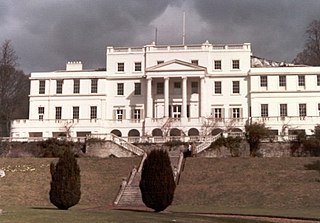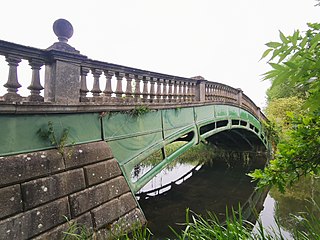
Culford Park in Culford, Suffolk, England, is a country house that is the former seat of the Bacon, Cornwallis and Cadogan families, and now it is the home of Culford School.

Culford Park in Culford, Suffolk, England, is a country house that is the former seat of the Bacon, Cornwallis and Cadogan families, and now it is the home of Culford School.
From at least 1429 the Coote family had lived at Culford and in 1524 Christopher Coote was lord of the manor. In 1540 Culford was granted by the Crown to the Bacon family and in 1591 Sir Nicholas Bacon built a red-brick hall on the same site as the present house. [1] The estate passed to the Cornwallis family in 1660 and during the middle of the C18 'T Wright' (possibly Thomas Wright (1711(86), the nationally renowned landscape gardener) was employed. Wright produced a map of the park dated 1742 which shows a formal landscape of avenues, rides and vistas, through geometrically shaped blocks of woodland. Between 1790 and 1796 Samuel Wyatt was commissioned to remodel the house for the first Marquis Cornwallis and in 1791 Humphry Repton (1752-1818) provided advice on landscaping the park, preparing a Red Book in 1792 (Williamson 1993). The estate remained in the Cornwallis family until the second Marquess died in 1823, by which time it had been greatly extended. Culford was sold the following year to Richard Benyon De Beauvoir and an estate map of 1834 shows the major expansion of the designed landscape on all boundaries. From circa 1839 the Rev Edward Benyon continued to embellish the estate. In 1889 the estate was sold again, this time to the fifth Earl Cadogan who commissioned the architect William Young to remodel the house in the Italian style. New stables were built, the gardens were altered and considerable additions made to the village.
Following the death of the sixth Earl in 1933 the estate was sold. The core of the park, together with the house, became the home of Culford School (bought 1935) in whose hands it remain today.
Crossing the lake to West of the Hall is an iron bridge constructed by Samuel Wyatt c.1804. The design is closely based on a bridge patented by Wyatt in 1800 [2] and is made of channelled granite abutments from which five tubular cast-iron sections repeated six times form the 60ft span, the largest of the eight surviving cast iron bridges built between 1790 - 1810. The 80 tons of iron castings were produced by Hawks and Co of Gateshead at a cost of £1,457. [3] The bridge is of exceptional interest as one of the earliest bridges with an unmodified cast-iron structure to survive, and is the earliest known example with hollow ribs. The structure received a grade I listing on 15 May 1996. [4]

James Wyatt was an English architect, a rival of Robert Adam in the neoclassical and neo-Gothic styles. He was elected to the Royal Academy of Arts in 1785 and was its president from 1805 to 1806.

Hartham Park is a Georgian manor house in Wiltshire, England, about 1+1⁄4 miles (2.0 km) north of the town of Corsham. Originally designed by James Wyatt, and set today in 50 acres (20 ha), it has within its grounds a stické tennis court. The house and nearby buildings were developed as a private business park in the late 1990s, although the house retains its Georgian facade and look.

Euston Hall is a country house, with park by William Kent and Capability Brown, located in Euston, a small village in Suffolk located just south of Thetford, England. It is the family home of the Dukes of Grafton.

Culford is a village and civil parish about 4 miles (6 km) north of Bury St Edmunds and 62 miles (100 km) north east of London in the West Suffolk district of Suffolk, England.
Samuel Wyatt was an English architect and engineer. A member of the Wyatt family, which included several notable 18th- and 19th-century English architects, his work was primarily in a neoclassical style.


Redgrave is a village and civil parish in Suffolk, England, just south of the River Waveney that here forms the county boundary with Norfolk. The village is about 4+1⁄2 miles (7 km) west of the town of Diss. The 2011 Census recorded the parish population as 459.

Shrubland Hall, Coddenham, Suffolk, is a historic English country house with planned gardens in Suffolk, England, built in the 1770s.

The Butterley Company was an English manufacturing firm founded as Benjamin Outram and Company in 1790. Its subsidiaries existed until 2009.

Sir Nathaniel Bacon, was an English painter, landowner and horticulturist from Culford, Suffolk.
Richard Benyon De Beauvoir (1769–1854) MP was a 19th-century British landowner, philanthropist and High Sheriff of Berkshire.

Newark Park is a Grade I listed country house of Tudor origins located near the village of Ozleworth, Wotton-under-Edge, Gloucestershire. The house sits in an estate of 700 acres (2.8 km2) at the southern end of the Cotswold escarpment with views down the Severn Valley to the Severn Estuary. The house and estate have been in the care of the National Trust since 1946.
Sir Nicholas Bacon, 1st Baronet, of Redgrave, Suffolk, English Member of Parliament. In 1611 he became the first man to be made a baronet. Bacon would serve on many commissions. The Privy Council constantly called upon him to conduct inquiries. He was a puritan leader in Suffolk. The power and prestige of the puritan ministries in many areas of the country owed their power to Bacon. Sir Nicholas Bacon was considered a good Christian by his contemporaries. Especially his chaplain, Robert Allen. Robert Allen stated that Sir Bacon's wife was dedicated to "God's holy religion and worship by every good and Christian means in the sight of men."

Heveningham Hall is a Grade I listed building in Heveningham, Suffolk. The first house on the site was built for the politician and regicide William Heveningham in 1658. The present house, dating from 1778 to 1780, was designed by Sir Robert Taylor for Sir Gerald Vanneck, 2nd Baronet with interiors by James Wyatt. The hall remained in the Vanneck family until 1981.

Jane, Lady Cornwallis, later Lady Bacon, was an English courtier and letter writer, whose correspondence was published.

Linton Park, formerly Linton Place or Linton Hall, is a large 18th-century country house in Linton, Kent, England. Built by Robert Mann in 1730 to replace a much earlier building called 'Capell's Court', the estate passed through the ownership of several members of Mann's family before coming into the Cornwallis family. The house was enlarged to its current size in 1825.

Sennowe Hall is a large country house and estate located near the village of Guist in Norfolk, England.

Hagley Hall was formerly a country house on the outskirts of Rugeley, Staffordshire. After it came into the ownership of the Curzon family, the estate became known as Hagley Park and appeared under that name in 19th century gazetteers, where it was described as "a fine old house and grounds". The site was progressively demolished during the 20th century.

Brabyns Park is a public park in Marple Bridge, Stockport, Greater Manchester, England.

The Iron Bridge is a grade I listed early cast iron bridge crossing a tributary of the River Lark in grounds of Culford Park in the village of Culford near Bury St Edmunds, Suffolk.